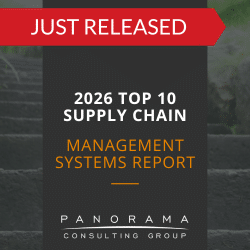You’ve heard about the benefits of digital transformation, and you’re considering implementing an ERP system. However, you’re a little daunted after reading about the high rate of failure among these types of projects.
Thankfully, you don’t have to meet the same fate. Your planned ERP implementation, SCM implementation, or CRM implementation can succeed from the very beginning. It all starts with understanding inherent ERP risk factors and what you need to do to mitigate them.
6 ERP Risk Factors
1. Focusing More on Technology Than People
Of course, you want to get the technological components of your ERP project right. You should no doubt meet with ERP vendors, analyze technical features, and conduct extensive testing.
However, it’s important to allocate just as much effort to the people side of the project.
Any time you implement enterprise software, you’re directly impacting business operations. Employees are asked to abandon their familiar best practices and adopt new workflows. Further, they’re tasked with learning the ins and outs of a system they’ve never used before.
By prioritizing organizational change management (OCM), you can ensure you’re dedicating the time, money, and resources required to help your workforce successfully make this transition.
In our ERP consulting experience, our computer software expert witnesses have found that most of the time, ERP failures are caused by project teams that under-prioritize OCM, assuming that end-user training is enough to get their teams up to speed.
A Failed Payroll System Implementation
Panorama’s Expert Witness team was retained to provide a forensic analysis and written report to the court regarding the failed implementation of a major software developer’s ERP/payroll system.
2. Selecting the Wrong Software
As you begin evaluating ERP software or SCM software, you’ll discover that there are countless solutions on the market. You may be tempted to fast-track your decision.
Unfortunately, if you rush the software selection stage, you could end up with an ERP solution that doesn’t fit your needs or won’t scale with your company.
To prevent this, it’s important to gather business requirements by identifying pain points and mapping your process. During this process, you should define business goals – both short-term and long-term.
Once these exercises are complete, you’ll have a clearer view of the requirements to prioritize when evaluating systems.
Conducting requirements gathering before ERP selection is a lifesaver (and time saver) whether you’re looking for the best ERP for manufacturing or the best CRM for your retail business.
3. Neglecting Business Process Reengineering
As mentioned above, process mapping is essential. But how do you arrive at your ideal future state processes?
In many cases, you’ll use business process reengineering. As you find inefficiencies, you’ll redesign your workflows to solve these issues.
We recommend keeping your process maps high-level so you can avoid customizing the ERP solution too extensively. The more you adopt best practices, the less likely you’ll have to purchase third-party add-ons or customize the solution around your unstandardized processes.
4. Overlooking Security or Privacy Threats
An ERP system consolidates and centralizes data across the enterprise. As such, it’s critical to have robust security measures in place to safeguard organizational data.
Even a minor breach could leave a significant number of records exposed, affecting individual employees, countless customers, and your overarching business.
To reduce this risk, you must have a security strategy and controls in place. In addition, it’s important to purchase ERP software from reputable, experienced vendors. Before you commit to their solution, ask them to describe their approach to mitigating security threats and protecting your business.
5. Low Executive Buy-In
To gain buy-in, you must show executives how the investment will benefit the enterprise and what specific changes they can expect.
Then, once they approve the project budget, you must convince them to remain involved in the project management process.
For example, these leaders should form an executive steering committee that guides the organization’s ERP implementation process and makes decisions concerning resource allocation, project timeline, and budget.
6. Poor Data Quality
Don’t transfer incomplete or inaccurate records from your legacy systems into your new platform. Similarly, don’t transfer multiple records or files that contain duplicate information.
An ERP system implementation involves departments across your enterprise, so there’s a good chance that inconsistent data will arise. As such, be sure to allocate plenty of time to data migration and testing to ensure all records are thoroughly examined before you implement the system.
ERP Risk is Inevitable. ERP Failure Isn’t.
These common ERP implementation risks demand vigilance. By taking precautions at the beginning, you can set the stage for a successful digital transformation.
When you know which steps to prioritize, it becomes easier to align the software with your business goals.
Our ERP consultants can help mitigate ERP risk and avoid ERP failure. Request a free consultation below to learn more.















